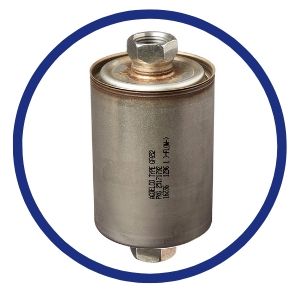A bad fuel filter is a serious issue that can keep your vehicle from reliably running. When the filter goes bad, limits the amount of fuel that enters the engine. If it doesn’t let fuel in at all, the vehicle will not run. With that in mind, most of the symptoms of a bad fuel filter revolve around the vehicle stalling out.
Fuel filters have been making a rearward progression for the last 50 years, literally. For a long time, you’d find it under the hood. It looked like a little pill, and it would be quick and easy to replace. This was in the era of carbureted vehicles. Now, they are much more difficult to find
Things began to change in the 80’s. Fuel injection requires higher fuel pressure. Higher fuel pressure meant that a more robust fuel filter would be required. This meant the fuel filter was no longer left under the hood. It was put in the steel fuel line, between the gas tank and engine bay.
These fuel filters were more reliable, but they also were tougher to change. Replacing them meant getting under the vehicle and disconnecting steel fittings. It really still isn’t that difficult to deal with, as long as it’s not being changed with fuel pressure in they system still.
The good news is, no matter how old your car or truck is, the symptoms of a bad fuel filter are universal. It doesn’t matter if it’s in-tank or in-line.
Bad Fuel Filter Symptoms

There are physical signs that you can feel when your fuel filter is clogged. Before taking anything apart, check to see if your engine’s computer has any trouble codes saved in it, this could save you a lot of time in making the diagnosis.
The engine may throw a P0087 trouble code. This trouble code detects that the fuel rail/system pressure is too low. Any trouble codes that exist could be a clue. Sometimes when there is low fuel pressure, you may also get an oxygen sensor related trouble code as well. The real issue with diagnosing a bad fuel filter is that it resembles many other vehicular issues in terms of symptoms.
Here are the most common symptoms of a bad fuel filter in your vehicle:
Sputtering
The only way that you are going to know that your vehicle’s fuel filter may be going out is that it is no longer letting enough fuel through to keep the engine running under a heavy load, or at high-speed. Typically, if you are heading up a hill (or accelerating) the engine may start to feel like it is just running out of steam. That’s what it feels like with a bad fuel filter.
A bad fuel filter can also feel a lot like a bad catalytic converter. Both conditions will make the motor feel like it is running out of wind when you hit the gas. A bad catalytic converter will not feel as jarring. It’s a smooth lack of power. If you are unsure, check out this article on troubleshooting catalytic converters. If you get P0420 or P0430 trouble codes with a scanner, it very well may be the catalytic converter causing these symptoms.
Hard to Start Engine
One of the best indicators of a clogged fuel filter is going to be that your vehicle is difficult to start. This is because there’s not enough fuel pressure to properly atomize the fuel as it enters the combustion chamber.
If your car is difficult to start, a clogged fuel filter would probably not be the place to start looking, particularly if you are not getting a trouble code for fuel pressure or the oxygen sensors.
Instead, we’d recommend taking a look at the ignition system first. Often it’ll be bad spark plugs, or a bad coil pack.
Engine Not Starting
If the fuel filter has become so clogged that the minimum amount of fuel has not been let through it, your engine won’t start at all.
At the most basic of levels your car or truck needs three things to start: Air, fuel, and spark. If any of these things aren’t present, the engine won’t turn over at all. If there’s been zero warning that the fuel filter could be going bad (hesitation, difficulty starting, etc) then a clogged fuel filter might not be the place to start. It could certainly cause the problem though.
Here’s a great video on using your eyes to diagnose the fuel filter:
It Could be the Fuel Pump
A fuel pump that is going out is going to feel the same as a bad fuel filter. This makes telling if you have a bad fuel pump or bad fuel filter difficult.
How do you tell them apart? A clogged fuel filter will have high pressure on its input side and low pressure on its output side. They are both going to cause the same hesitation at high speed and difficulty starting. The only way to truly tell is to place a fuel pressure gauge on both sides of the line and get a reading from both.
If your vehicle isn’t starting at all, and you hear the fuel pump prime that is usually a good indication that the pump is working to some capacity. Testing the fuel pressure on each side of the pump would be the best way to diagnose this problem.
A priming fuel pump sounds like a high-pitched whine for a few seconds and can be heard with a sharp engine right after the ignition key is turned, but before the starter is engaged.
Conclusion: Bad Fuel Pump Diagnosis
The symptoms of a bad fuel pump match a lot of other common problems that can occur in your vehicle. Testing the filter and pressure on each side of it are going to be the quickest ways to rule it out. If there is anything you would like to add, please leave a comment below. Good luck!
